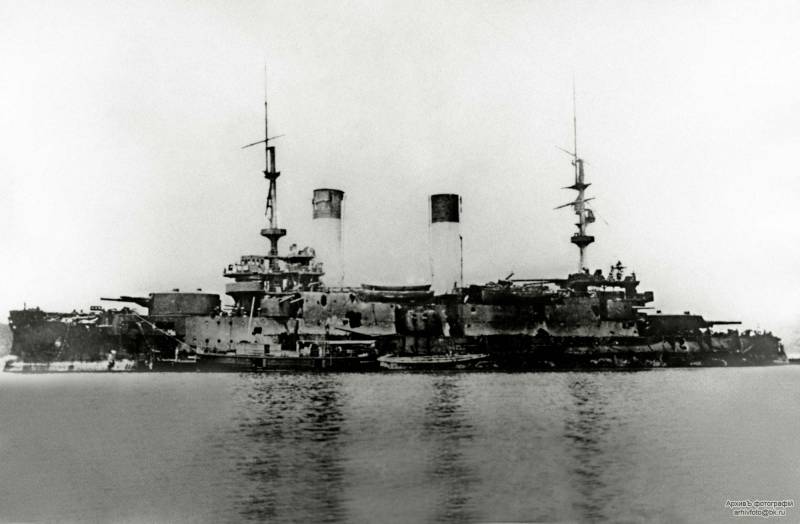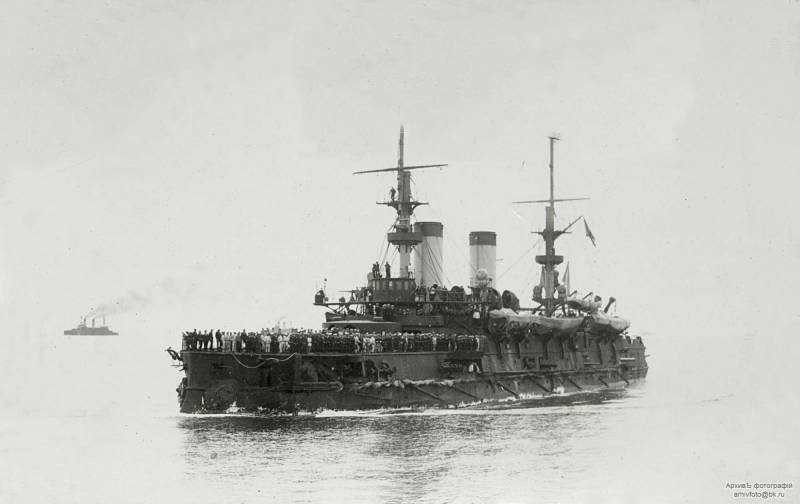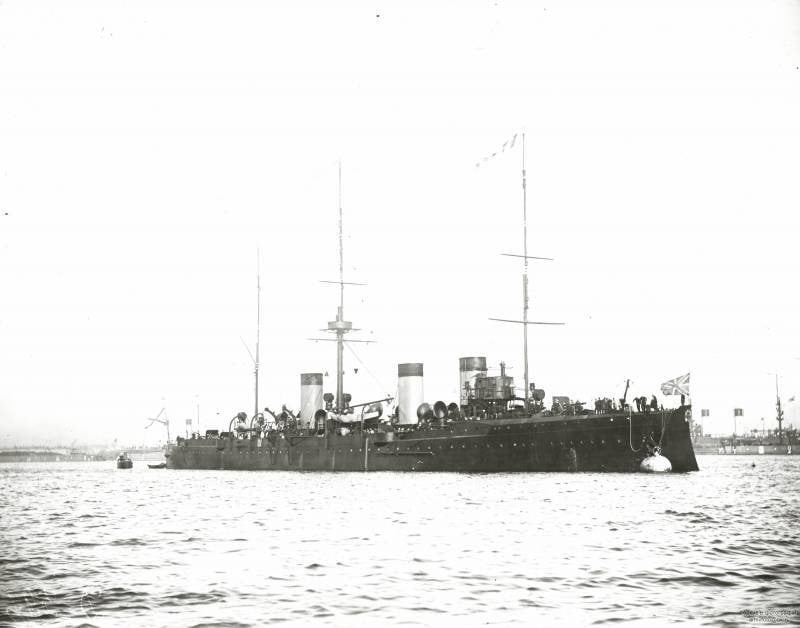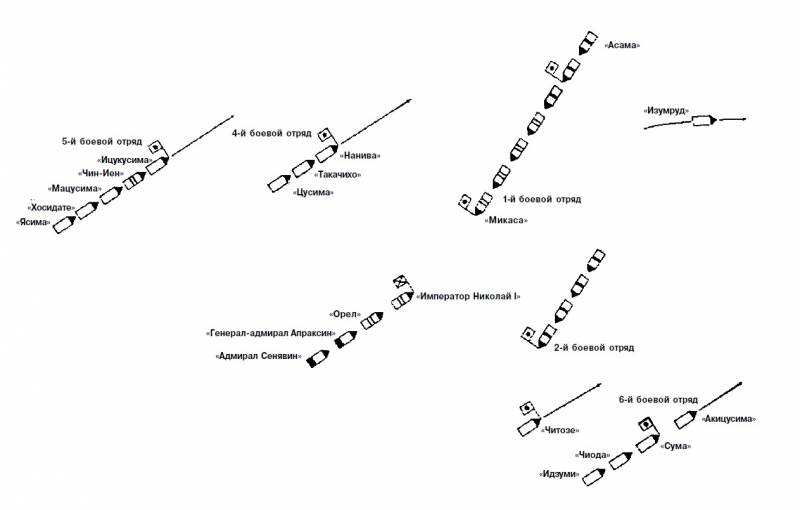Without lowering the flag. The actions of the cruiser "Emerald" in the morning and afternoon of 15 May in Tsushima
As mentioned earlier, the night from 14 to 15 in May was relatively calm for Emerald - the cruiser was on the left traverse of the Emperor Nicholas I and, as far as can be understood from the commander’s report, did not open fire. However, no one on the ship closed his eyes, so the night turned out to be sleepless for the crew.
Joyless morning
At dawn, the Emerald team bitterly discovered that a squadron of five ships remained from the once large Russian squadron: the squadron battleships Imperator Nikolai I and Orel, the coastal defense battleships General Admiral Apraksin and Admiral Senyavin, and also of the Emerald itself. About 05.00 in the morning, this squad was approximately 100 miles from Fr. Dazhelet and continued to move to Vladivostok: at the same time, the Japanese main forces were approximately 30 miles from Fr. Dazhelet, to which they retreated in order to be in the morning between the remnants of the Russian squadron and Vladivostok.
Almost immediately, one can say, with the first rays of the sun, the Russian ships were discovered. The Japanese 6 combat detachment saw the smoke, immediately reported it to other detachments and, adding speed, went towards a rapprochement. Finding out that there are four battleships in front of him, including two coastal defenses, followed by a cruiser, the 6 group has again reported this to all the detachments and started tracking.
Of course, the other Japanese ships immediately moved to the remnants of the Russian squadron. The 5 battle squad, the ubiquitous Chin-Yen, Itsukushima, Matsushima and Hassidate, who were accompanied by the Yayayam aviso, as well as the cruisers Otova and Niitaka, were the first to arrive. It was this detachment who informed H.Togo about the discovery of the remnants of the main Russian forces tentatively in 05.00: despite the fact that the 6th detachment twice made radio news of the same, both of his radiograms on Mikas were not received. At the same time, according to the reports of the Russian officers, it turns out that the 6 combat unit went unnoticed, and the first Japanese ships that we saw on our squadron were the 5 squadron cruisers: they were to the left of the Russian battleships, the closest to them was “Emerald ".
Having discovered the smoke, as it seemed then, of a single ship, they immediately informed the Emerald about this with a signal to Rear-Admiral N.I. Nebogatov, but even before the answer was received from Emperor Nicholas I, the amount of smoke increased to four. "Emerald" and reported this to the "Nikolai", but the amount of smoke has increased again - now to seven.
In fact, discrepancies with the Japanese version of the same events begin here. According to the report of the commander of "Emerald", Baron V.N. Ferzen, one of the Japanese Suisers, such as the Suma, separated from the rest of the ships and became close with the Russians at a distance of good visibility in order to properly consider the remnants of our squadron. But the Japanese themselves do not write about this, besides, “Suma” and “Akashi” were still two-pipe, “Otova” and “Niitaka” were three-pipe, “matsushima” had only one pipe, so that they were confused at a “good distance visibility ”would be rather difficult. However, the Japanese could simply not mention this maneuver of one of their cruisers, and confusing cruisers at dawn is not that difficult.
Then on “Emerald” they saw that “Emperor Nicholas I” and “Eagle” increased the course - given that no one else describes this, it is not clear how such an illusion came about. But Baron V.N. Ferzen suggested that N.I. Nebogatov is going to give a signal "save yourself who can," that is, to break through the ability of one by one. Then "Emerald" got close to "Nikolai", and with a semaphore he asked the admiral for permission to follow Vladivostok at high speed. But N.I. Nebogatov, who was not going to do anything like that, ordered the Emerald to remain in place, so that the cruiser returned to the left traverse of the flagship battleship.
Then the rear admiral asked the battleships about the status of their artillery, the response received satisfied him, only Senyavin reported: "I have minor damage, I will soon fix it." After that N.I. Nebogatov ordered to prepare for battle and turned left, towards the Japanese cruisers. The latter did not want to take the fight and also turned away to the left. Official Japanese historiography silences this episode - again, perhaps due to its insignificance.
Although nowhere in the reports is not stated directly, but when the flagship N.I. Nebogatov turned on the Japanese, "Emerald" apparently moved to another side of the squadron. That is, if earlier he was on the left beam of the Emperor Nicholas I, now he has taken a position on his right beam or elsewhere, but to the right of the battleships. The point here is this. When the “Emperor Nicholas I” lay down on the same course, there was still some smoke behind the stern - perhaps it was the 6 unit. Then the Russian admiral ordered a semaphore "Emerald" to inspect the enemy ships. On the cruiser they did not understand which ones, and asked again: N.I. Nebogatov said that we are talking about the Japanese detachment to the left of the squadron. "Emerald" gave full speed and immediately went to execute the order. But according to the report of V.N. Ferzen, for this the cruiser was forced to turn, and pass under the stern of the battleship. A maneuver, completely unnecessary and even impossible, if the Emerald were on the left side of the N.I. Nebogatova, but understandable, if the cruiser was on its right side. And, again, if the squadron was going to take the battle of the left side, then, of course, it would be logical for the small cruiser to be on the starboard side, but not from the left side.
"Emerald" went to rapprochement with the Japanese detachment and, after conducting reconnaissance, quickly returned with a report: alas, the quality of reconnaissance turned out to be not so hot. Only three "matsushima" were correctly identified, but the "emeralds" reported on the presence of "Yakumo", with which, apparently, "Chin-Yen" was confused, and "Otova", "Niytaka" and the “Yayayam” memo with some then miraculously turned into "Akitsushima" and three small cruisers.
Reporting the composition of the enemy forces to the admiral, "Emerald" took place on the right side of the "Emperor Nicholas I". The battleships tentatively had a 12-13 junction, and the Japanese squad, seen from the stern, gradually approached. In what happened next, there is a discrepancy in Russian documents.
Meeting the main forces
Official Russian story reports that the Japanese were approaching the squadron from all sides, that Admiral X. Togo, not even seeing the Russian battleships, in 08.40, sent the 2 second combat squad forward for reconnaissance. In 09.30, the Kamimura cruisers found Russian ships on the right side of the course, respectively, at that moment they themselves were in the right shell of our squadron. Then N.I. Nebogat sent "Emerald" to explore for these new forces.
But V.N. In his report, Fersen states something else: that he was sent not to the enemy cruisers that appeared in front and to the right, but to the detachment that was catching up the Russians from the stern. Of course, the cruisers H. Kamimury could not catch up with the Russian detachment, so we can talk only about the 6 combat detachment, which consisted of the Akitsushima cruisers, Suma, Izumi and Chiyoda, probably this time was next to them.
Most likely, it was the Commander of the Emerald who made a mistake - having come close to the Japanese squad, he discovered that it consists of 4 armored and 2 armored cruisers, which is completely different from the 6 battle squad. Returning to the flagship battleship, "Emerald" reported the results of intelligence. In response, N.I. Nebogatov asked if Russian ships were still visible, and if so, which ones. On this V.N. Ferzen replied that he had not seen any Russian ships on the Emerald.
At the same time, the main forces of H. Togo — the 4 of the battleship, accompanied by “Nissin” and “Kasuga,” appeared; Ferzen in his report accurately indicates their place: between the 5-th combat detachment and the armored cruisers, which reconnoitered "Emerald", which indirectly confirms the hint expressed earlier by the author about the error in the report of his commander. After all, if V.N. Ferzen went on reconnaissance to the 6-th detachment, and took him for the armored cruisers of the Japanese, he still could not help but notice the 2-th combat detachment, which was between 1 and 6-th, and had to somehow mention in his report, like ships between armored cruisers and the main forces of Kh. Togo. Meanwhile, nothing in V.N. Fersen no.
Be that as it may, the Japanese troops surrounded the remnants of the Russian squadron.
There is no doubt that the spectacle of all 12 armored ships with no visible damage was a real shock for Russian sailors. It turns out that for all the time of the fierce 14 battle in May, two of our squadrons failed to not only sink, but even seriously damaged at least one battleship or an enemy armored cruiser. Alas, it was so. Russian gunners in Tsushima showed themselves quite well, the total number of Russian hits of all calibers in Japanese ships, according to Japanese data, reached 230. N. J.M. Campbell wrote further:
But a small amount of explosives in Russian projectiles caused the Japanese not to inflict serious damage on the hit, and therefore in the morning of May 15 the remnants of the Russian squadron met the 4 battleship and 8 armored cruisers of the 1 and 2 troops. And the only visible damage on them was a shot down stubby on Mikas.
Delivery
As mentioned above, in 09.30 armored cruisers X. Kamimura established contact with Russian ships, but did not enter the battle on their own, awaiting the approach of the main forces of X. Togo. Then, when the Japanese battleships approached, the 1-th and 2-second combat detachments became close to the squadron of N.I. Nebogatov on 60 cables and opened fire on the 10.30 tentatively. From the "Eagle" the Japanese responded with fire, but "Emperor Nicholas I" lowered the stern, rear admiral and steng flags, and then raised the signals of the international code "surrounded" and "surrender." Then from the board of "Nicholas" to the rest of the ships of the squadron was transferred to a semaphore: "Surrounded by the superior forces of the enemy, forced to surrender."
Without a doubt, the Japanese really had a tremendous superiority in forces - in fact, the five Russian warships were opposed by the enemy's 5 combat units. But still there is no doubt that the decision of N.I. Nebogatov on the surrender fell indelible shame on the honor of the Russian Imperial Navy.
"Breakthrough" Emerald "
For the “Emperor Nicholas I”, the surrender signals were raised by the remaining three battleships, and on the “Emerald” he was rehearsed (apparently, on the machine), but then they realized it and lowered it. V.N. Fersen immediately ordered to assemble a team. This is how the mine foreman and N. N. M. Emerald radio telegraphist describe his commander. Sobeshkin:
V.N. Ferzen did everything so that "Emerald" squeezed the maximum out of their boilers and machines. Down to the boiler rooms were sent marines to help the stokers - to bring coal. The cruiser began to smoke heavily, its hull, crashing into the sea, raised waves that almost reached the upper deck of the ship. In order to facilitate the nasal tip, the anchor chains were riveted, and they, together with the anchors, went into the depths of the sea. The cruisers radio operators tried to interrupt the Japanese radio communications with amplified signals.
The course of "Emerald" is not quite clear. Official Russian and Japanese historiography say that the cruiser went east, but V.N. Fersen in the report points out: “I laid down on SO, like a course, equally diverting from the cruisers to the right and left.” SO is southeast, and most likely, the situation was such that at first “Emerald” went exactly to the southeast to go between 2 and 6 units of the Japanese, and then turned to the east. In pursuit of him, the 6 squadron cruisers went, but, of course, they could not catch up with him, and only the Akitsushima, along with the nearby Chitose, were still trying to catch up with the Russian ship. True, at the Emerald itself they were believed to be pursued not by two, but by three cruisers: the Niitaka, the Chitose and the Kasagi. The chase continued for about 3-3,5 hours, from 10.30 to 14.00, after which the Japanese cruisers, seeing that they did not catch up with the Emerald, turned back.
Was there a battle between the Emerald and the cruisers chasing it? Apparently - no, although A.A. Alliluev and M.A. Bogdanov indicates that the shells of the pursuing Japanese cruisers "barely reached" to the "Emerald". On the other hand, the description of the participation of “Pearls” and “Emerald” by these authors, unfortunately, contains many inaccuracies, so relying on them is dangerous. As for the "Emerald", then V.N. Fersen explicitly states that the 15 of May did not have to “shoot,” that is, the cruiser did not return fire, apparently beyond the range.
How fast did the Emerald break through?
In the writings of historians one can find the opinion that in those approximately 3 hours, while the cruiser was still in view of the enemy pursuing him, the speed of the Emerald reached the 24 nodes, but this is extremely doubtful. Unfortunately, Baron V.N. Fersen did not report anything about the speed of his cruiser in his report, but we have the opinions of two officers of the Emerald - the navigator officer Lieutenant Polushkin and the senior officer of the cruiser, the captain of 2 rank Patton-Fanton-de-Verrion.
The first reported that the speed of "Emerald" at the breakthrough was "around 21 knots.", But the author of this article believes this estimate is erroneous. The fact is that in the testimony of the Investigation Commission, Lieutenant Polushkin reported: "Judging by the preceding tests, Emerald could have developed 14 in May at full speed near the 21 node." This opinion is quite logical, because on trials in Kronstadt the Emerald developed 22,5 ties, but, of course, in everyday service the ship is usually unable to show the same speed as on trials, and the transition from Libava to Tsushima negatively affected the state boilers and cruiser cars. So, from this point of view, the opinion of Lieutenant Polushkin looks quite reasonable.
But with all this, the navigator officer did not take into account that the 22,5 ties, shown by Emerald in the tests, were not the speed limit of the ship: the tests themselves were not completed due to the urgency of sending the cruiser after the departed 2 of the Pacific Squadron, to form which "Emerald" was late. Thus, it is not at all possible that the maximum cruiser speed was not “near the 21 node”, but higher. At the same time, although Polushkin never says it directly, but from the reading of his testimony by the Investigation Commission there is a persistent feeling that the lieutenant reasoned as follows: “If the maximum speed of the Emerald was about 21 knots, and during the breakthrough the cruiser developed a full move, it means that at the time of the breakthrough, its speed was about 21 knots. ”
At the same time, the senior officer of the Emerald, Patton-Fanton-de-Verrión indicates that the cruiser was moving at a speed of about 21,5 knots during the breakthrough. According to the author of this article, it is this assessment that is as close as possible to the truth.
But, no matter how fast the Emerald goes, without a doubt, its breakthrough through the tightening ring of the Japanese fleet is a heroic and highly worthy act, especially against the backdrop of the actions of the Japanese admiral N. And. Nebogatov.
To be continued ...




Information